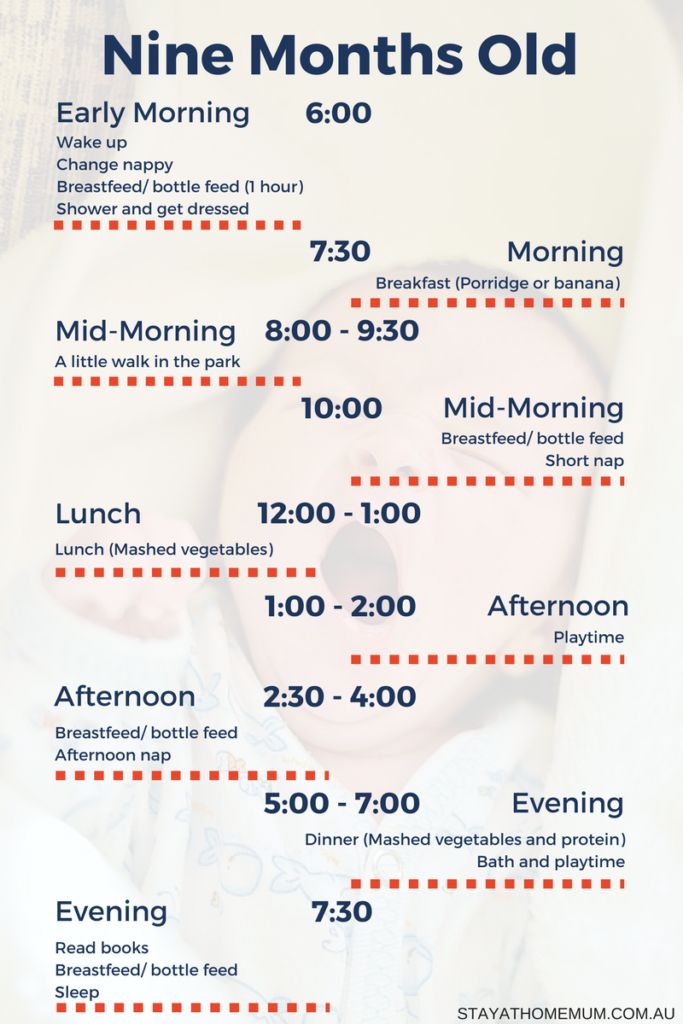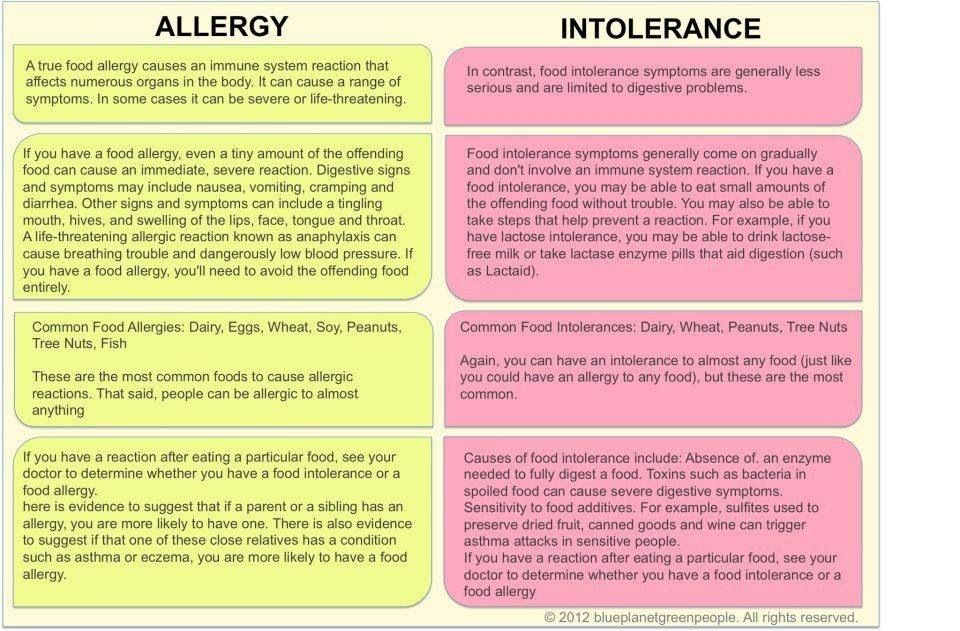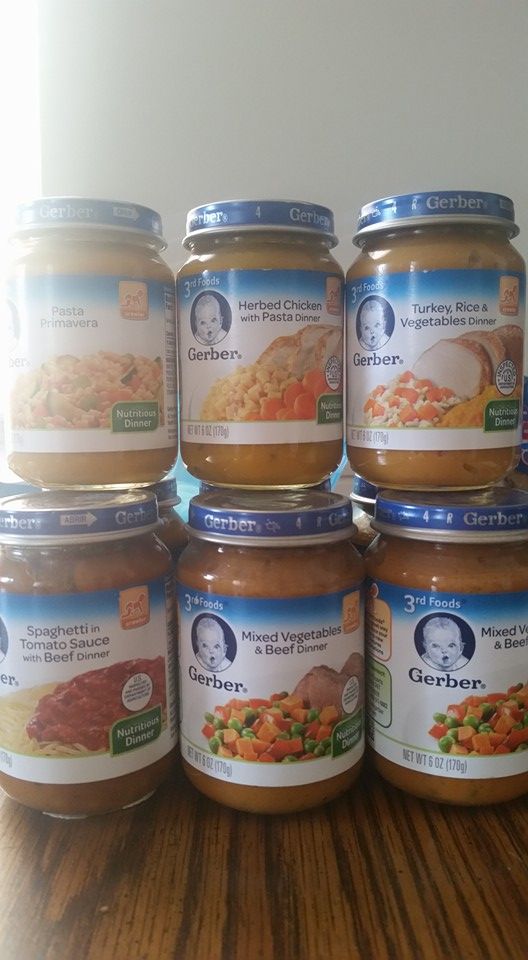Feeding salmon to babies
Salmon for Babies - MJ and Hungryman
Jump to Recipe
Introduce salmon to your baby with confidence with these cooking tips, serving suggestions, and easy recipes! Everything you need to know all in one place!
Jump to:- When to introduce salmon
- Is salmon safe for babies?
- Introducing Food Allergens to Baby
- Health Benefits
- Buying the best salmon
- How to cook salmon for babies
- Top Cooking Methods
- Salmon for Baby Led Weaning
- Storage Suggestions
- 3 Month Meal Plan for Baby Led Feeding
- Salmon Recipes for Baby
- How to Cook Salmon for Babies (3 ways)
When to introduce salmon
Salmon can be offered to babies as soon as they’re ready to start solids, usually around 6 months. It’s important to remember that your baby is unique and that rather than going by the calendar, you need to make sure your baby is DEVELOPMENTALLY ready to start solids.
If you’re unsure, be sure to grab my FREE handout!
Is salmon safe for babies?
As long as it is cooked properly and served in an age-appropriate way, as I show you here, it is safe. It also contains lower amounts of sodium compared to other fish.
Additionally, it is lower in mercury, making it a great option for pregnant moms and young children. That's because mercury can negatively impact the fetus and a child's brain and nervous system.
While it is a safer option, instead of eating salmon all the time, I encourage you to rotate with other low-mercury fish, like halibut and sardines. You will be able to incorporate more variety and help meet your baby and family's nutritional needs.
Introducing Food Allergens to Baby
Salmon as well as other finned fish are one of the top allergens, and if you were told to wait until around 2-3 years of age to introduce them, this is outdated advice!
The current recommendation is to introduce highly allergenic foods EARLY and OFTEN. By doing so, you can dramatically reduce the risk or actually help prevent the development of food allergies.
When first introducing, start with a small amount. Be sure it's the only new food on your baby's plate so that if there is an allergic reaction, you will know what caused it.
Be sure it's the only new food on your baby's plate so that if there is an allergic reaction, you will know what caused it.
Serve it at home early in the day so you can monitor your baby for any reaction(s) and get medical help if necessary.
Health Benefits
Salmon is a great source of many critical nutrients that babies need, such as iron, zinc, and vitamin D (much higher in wild-caught). It is a particularly excellent source of B12 , which is necessary for producing red blood cells, and omega-3 fatty acids, an essential nutrient for proper brain development.
Canned salmon is also a great source of calcium due to the edible bones.
Buying the best salmon
I don’t know about you, but with so many choices out there, buying salmon can feel overwhelming! My goal here is to help you make the best decision according to your needs and values.
Wild-caught vs. Farmed Salmon
Wild-caught:
- Means it caught in its natural environment
- Contains less toxins
- Has a deeper red color
- Has a higher ratio of omega 3 to omega 6 fatty acids.
 While both are essential, we tend to consume a lot more omega-6 fats and not enough omega-3s
While both are essential, we tend to consume a lot more omega-6 fats and not enough omega-3s
Farmed salmon (may be labeled as Atlantic salmon) contains pollutants, antibiotics, pesticides, and toxins from the fish farms. And depending on its feed, may contain lower amounts of nutrients than wild-caught salmon.
The "downside" to wild-caught salmon is that just like with shrimp, it is overfished. If sustainability is your concern, sockeye, coho, and king salmon from Alaska are great choices, according to the Marine Stewardship Council.
The Monterey Bay Aquarium's Seafood Watch site is a wonderful resource.
Wild-caught salmon is also more expensive, so if you want to enjoy it regularly and you are on a budget, this may pose a sustainability concern of a different nature.
Fresh vs. Frozen
Unless you are getting the fresh catch of the day from a fish mart, chances are what you find sold as "fresh" salmon at the supermarket isn't so fresh. Just like with shrimp and most other seafood, it was previously frozen and thawed for sale.
I personally love frozen salmon for the convenience! Also, it is flash frozen right after being caught to preserve freshness and nutrition. I purchase ours from Costco. Their wild-caught Alaskan sockeye salmon is amazing and individually packaged.
Fresh vs. Canned
Canned salmon is a wonderful option. It's convenient and nutritious. In fact, according to the USDA study, canned pink and red salmon was found to have higher amounts of omega-3 fatty acids than the fresh. It also delivers a powerful punch of calcium.
Just be sure to look for "no salt added" or "low sodium" and BPA free lining.
How to cook salmon for babies
What is the best way to thaw frozen salmon?
Thawing in the refrigerator overnight is the simplest and safest method.
If you forget, then first remove the fish from its packaging and place into a resealable plastic bag. Then submerge in a large bowl of cold water. Check after 30 minutes, being sure to change out the water every 10 minutes or so to ensure that the temperature remains below 40° at all times.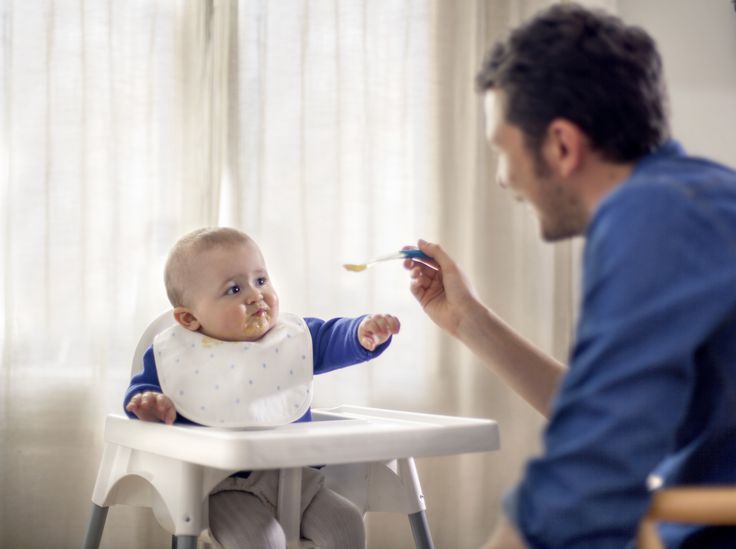
Should I wash the salmon first?
You don't need to wash salmon before cooking. In fact, USDA recommends against it as bacteria in the juices can spread to other foods and surfaces. The bacteria will get killed during the cooking process.
Should I leave the skin on or off?
On! It helps to hold the shape, allow for more even cooking, and retain juices. You can easily separate the skin once cooked.
How can I tell if the salmon is done?
Cooking time will depend on the fish’s thickness and the cooking method. Wild-caught salmon also has less fat than farmed salmon so it will take less time to cook.
The best advice I can offer is to use a thermometer. Aim for 140-145°F and be sure to pull the salmon FAST when it reaches temperature as it will continue to cook as it rests.
The salmon should flake easily with a fork and the flesh should appear opaque.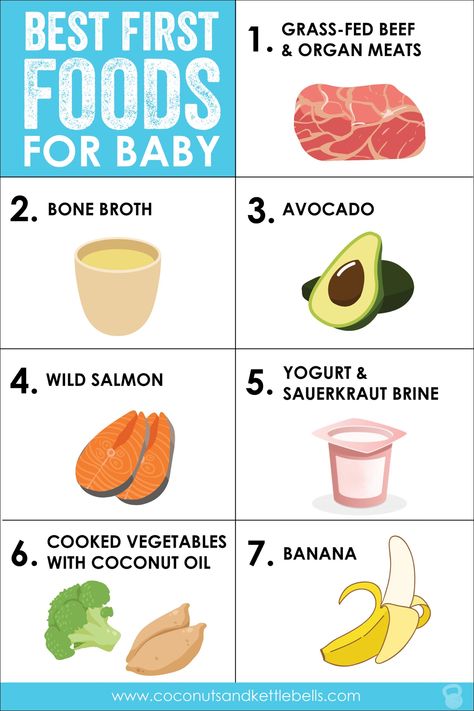
What is the white substance on top of my baked salmon?
Don't be alarmed if you see this. It’s due to the protein found in salmon called albumin, which solidifies when heated.
To minimize this white layer, bring the fillets to room temperature before cooking and avoid cooking at high temperature.
Top Cooking Methods
Regardless of which method you choose,
- Let the salmon come to room temperature. Take your fillets out of the refrigerator about 15 minutes prior to cooking. Don't let them sit out for too long!
- Be sure to check for any white pin bones running down the center of the fillet.
- Cook until salmon reaches the internal temperature of 140-145°F.
Steamed
Place water in a pot, add steamer basket, and bring to a boil. Add salmon, cover, reduce heat to medium and cook for 5-6 minutes.
Poached
Here are three ways you can poach salmon:
- This method requires minimal prep work.

- Place salmon in a deep skillet skin side down. Add water or broth so it barely covers the fish. Bring to a boil and once liquid starts bubbling, turn off the heat.
- Cover the skillet and let it sit for 10 minutes or so.
- If you want to infuse more flavor into your salmon,
- Add cold water or stock and aromatics of choice (optional), such as dill, onion, celery, to a deep skillet. While I haven't tried it yet, I've heard that poaching in milk is good too.
- Bring to a boil then reduce heat to a gentle simmer.
- Add the salmon skin-side down and cover. Cook for 5-10 minutes, depending on the thickness of the fillet.
- You can also poach in a sauce alongside other ingredients, like this poached cod. Simply substitute with salmon. It's SO flavorful!
Baked (Steam roasted)
Line a baking pan with parchment paper as stuck-on salmon skin is hard to scrape off. Place salmon on top and season with melted butter or oil and seasoning(s) of choice.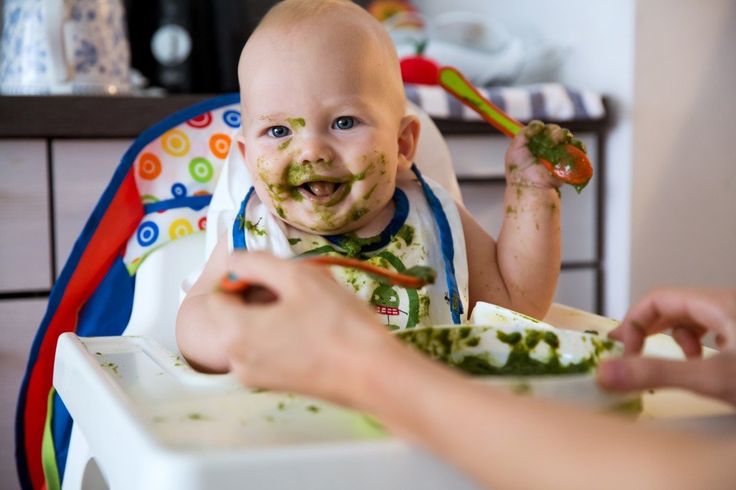 I also like to add some lemon wedges.
I also like to add some lemon wedges.
Cover the pan and bake for about 10-15 minutes, depending on the thickness.
Salmon Cakes
You can use fresh or canned salmon for this. It's such an easy and delicious way to serve salmon to your baby along with vegetables and spices! These cakes also freeze well.
Salmon for Baby Led Weaning
First be sure to carefully inspect the salmon for tiny bones. Even when salmon is labeled as boneless, it is possible to have tiny bones in it.
Once you've cooked the salmon using any of the methods mentioned, here's how to serve it to your baby.
6+ Months Old
- Offer finger-shaped, 1-2 adult finger-width pieces.
- Flake into tiny pieces and add to other foods, such as:
- Lentils
- Homemade baby oatmeal
- Yogurt
- Scrambled eggs
- Vegetable omelette
- Vegetable French toast
- Salmon cake - offer whole
- Salmon quiche
9+ Months Old
By 8-9 months of age, your baby should develop their pincer grasp and be able to pick up smaller pieces.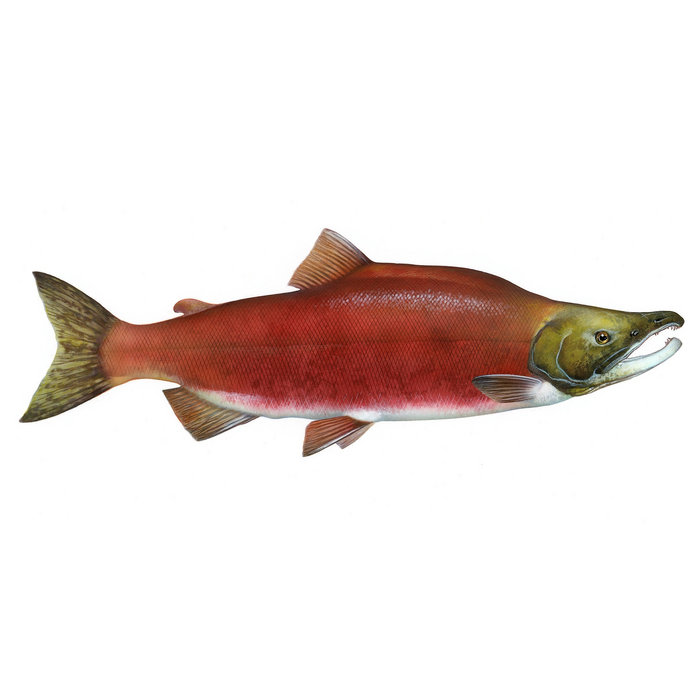 In addition to all the suggestions above, you can start offering bite-sized pieces.
In addition to all the suggestions above, you can start offering bite-sized pieces.
Storage Suggestions
For uncooked salmon:
- Use fresh salmon within one to two days upon purchase. If the fish is packaged, refer to the packaging for the ‘best before’ date.
- Store unused fresh salmon in a vacuum or airtight freezer bag in the freezer for up to three months.
- Store canned salmon unopened at room temperature for up to three years. Check the ‘best before’ date when purchasing the can.
- Once the can is open, remove the salmon from the can, store it in an airtight container, and use it within three to four days.
Cooked salmon
- Transfer to an airtight container and keep in the refrigerator for up to 3 days.
- To freeze, make sure salmon is completely cooled. Wrap in parchment paper or plastic wrap and place in freezer bags. Squeeze out excess air and freeze for up to 3 months.
3 Month Meal Plan for Baby Led Feeding
Are you:
- getting ready to start or at the beginning stage of introducing solid solids and feeling overwhelmed?
- stuck on purees and having a really difficult time transitioning to table food?
- or tired of serving the same foods on repeat and want to offer more variety of foods to your older baby or toddler?
If so, my 3 MONTH Baby Led Feeding Journey Program may be just what you are looking for!
It's a complete roadmap that would show you through daily videos and photos of what foods and how to serve them to your baby AND the rest of the family at the same time.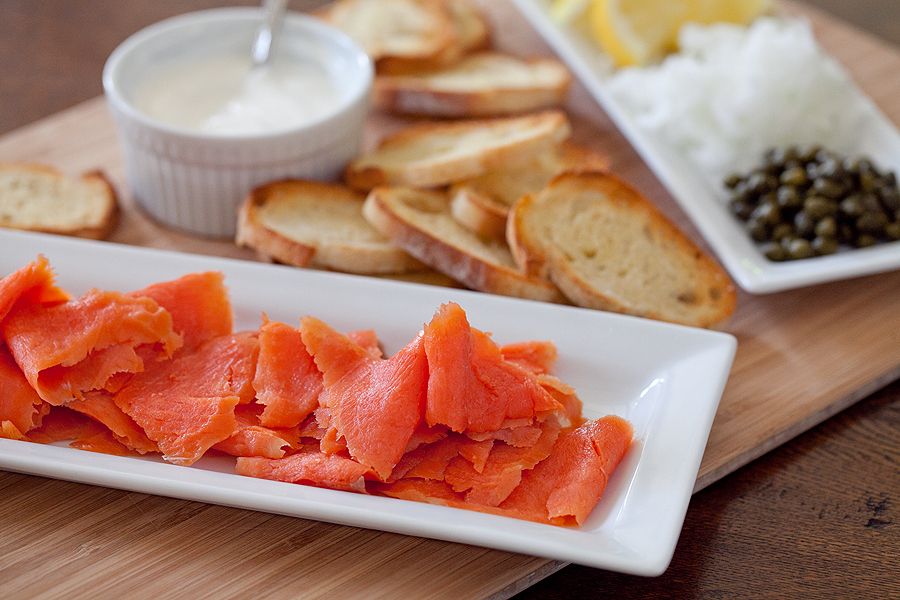 Everything you need to know all in one place!
Everything you need to know all in one place!
Do you want to minimize picky eating and set a solid foundation for a lifetime of healthy eating habits?
Check out this 3 month mastering self-feeding program! It’s the closest thing to me being in your kitchen
Salmon Recipes for Baby
Did you make this recipe? Leave a rating below and let me know how you liked the recipe! Your feedback means so much to me!
How to Cook Salmon for Babies (3 ways)
Introduce salmon to your baby with confidence with these cooking tips, serving suggestions, and easy recipes! Everything you need to know all in one place!
5 from 3 votes
Print PinPrep Time: 5 minutes
Cook Time: 10 minutes
Total Time: 15 minutes
Servings: 4
Author: Min | MJ and Hungryman
- ▢
Steamer
- ▢ 2 (8-10 ounce) salmon fillets, skin on
- ▢ Oil or butter (for baked)
- ▢ Optional: seasonings, lemon wedges, aromamtics
Steamed
Place water in a pot, add steamer basket, and bring to a boil.
 Add salmon, cover, reduce heat to medium and cook for 5-6 minutes.
Add salmon, cover, reduce heat to medium and cook for 5-6 minutes.
Poached (two ways)
1. Place salmon in a deep skillet skin side down. Add water or broth so it barely covers the fish. Bring to a boil and once liquid starts bubbling, turn off the heat.Cover the skillet and let it sit for 10 minutes or so.
2. If you want to infuse more flavor into your salmon - add cold water or stock and aromatics of choice, such as dill, onion, celery, to a deep skillet .Bring to a boil then reduce heat to a gentle simmer. Add the salmon skin-side down and cover. Cook for 5-10 minutes, depending on the thickness of the fillet.
Baked (steam roasted)
- Cooking time will depend on the fish’s thickness and the cooking method. Wild-caught salmon also has less fat than farmed salmon so it will take less time to cook. Be sure to read the "How to cook salmon for babies" section for more details!
- Storage:
- Transfer to an airtight container and keep in the refrigerator for up to 3 days.
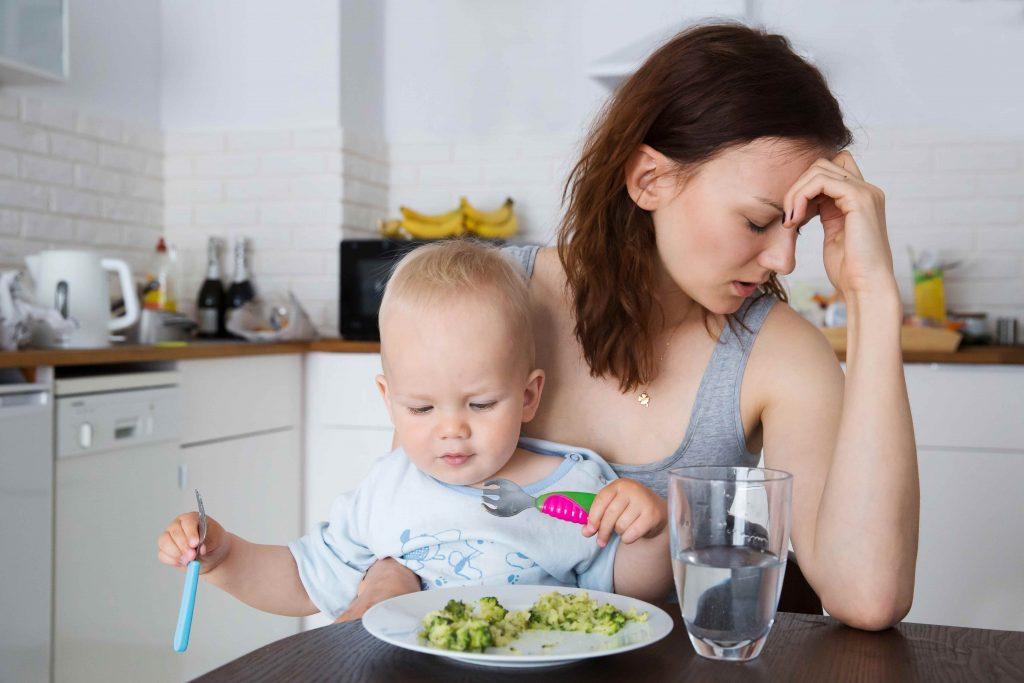
- To freeze, make sure salmon is completely cooled. Wrap in parchment paper or plastic wrap and place in freezer bags. Squeeze out excess air and freeze for up to 3 months.
- Transfer to an airtight container and keep in the refrigerator for up to 3 days.
Calories: 81kcal | Protein: 11g | Fat: 4g | Saturated Fat: 1g | Sodium: 25mg
Course Dinner
Cuisine American
Tried this Recipe? Tag me Today!Tag me @KidFriendly.Meals today!
The Best Way To Cook Salmon For Baby
Salmon is one of the best foods you can feed your baby. It’s rich in nutrients that growing babies need such as protein & fat. It’s packed with iron and vitamin D, which are two nutrients babies can often be deficient in and need for overall health. Plus, it is packed with DHA, which is good for brain health. Salmon also supplies omega-3 fatty acids and other essential vitamins that support normal eye development and serve as a natural immune booster.
Babies can begin eating solids anytime between 4-6 months. Definitely talk to your pediatrician before feeding your baby salmon, or any solids for that matter. However according to most sources, your baby is ready to eat solid foods in addition to their milk intake around six months old. Adding salmon to their diet can improve their supply of essential nutrients needed for their cognitive development.
Definitely talk to your pediatrician before feeding your baby salmon, or any solids for that matter. However according to most sources, your baby is ready to eat solid foods in addition to their milk intake around six months old. Adding salmon to their diet can improve their supply of essential nutrients needed for their cognitive development.
Before we get into our favorite way to cook salmon for babies, we can’t stress this enough. Make sure you ask your baby’s pediatrician before introducing salmon to his or her diet. Once you get approval, make sure you always cook the salmon properly to reduce the risk of food-borne illnesses. Salmon is a low-mercury fish and it is good for your baby to eat up two to three times per week according to BabyCenter.
Every baby becomes ready for solids at different stages so talk to your doctor before trying any solid or pureed food. Typically for babies 6-9 months old, you can mash cooked, flaked fish into a puree for easier digestion. Babies 9 months old and above can eat small pieces of breaded or baked salmon.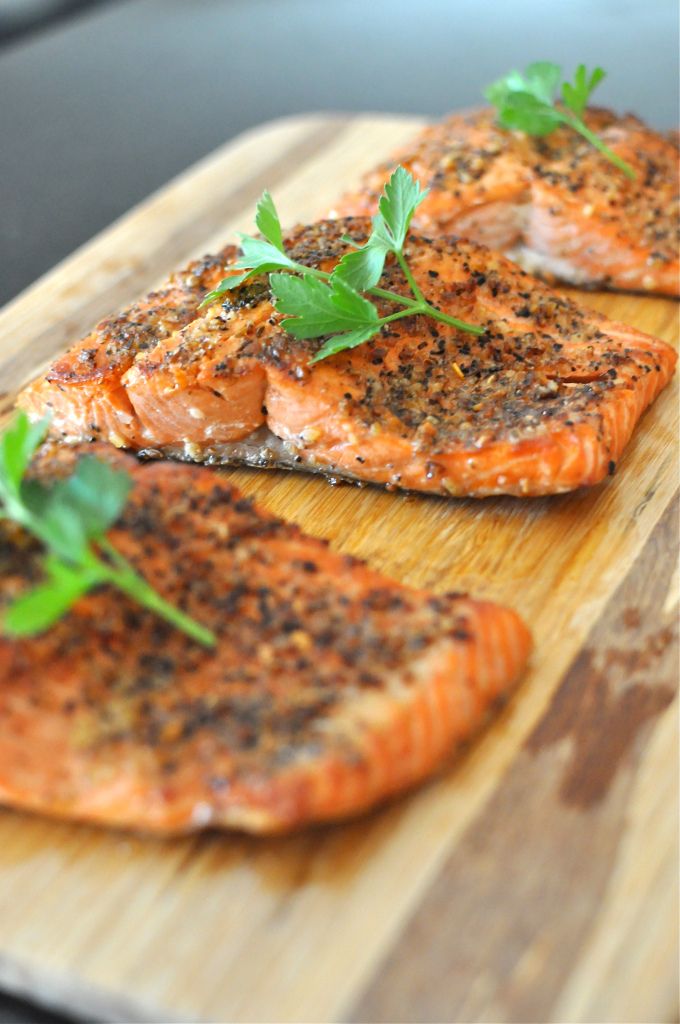
Our favorite baby salmon recipe: Boil the salmon & make a puree for baby!
There are many ways to cook salmon that make it more palatable for your baby. However, our favorite way is to make Oshēn Salmon into a puree after boiling it. It’s basic and a great way to introduce salmon. Plus, when you puree salmon you can eventually add in more flavors.
Over time you can even sprinkle the salmon with a small amount of herbs and spices to season your recipe. Since babies tend to have more sensitive taste buds than adults, don’t overdo it. Skip spicy seasonings like cayenne powder and focus on kid-friendly herbs such as basil, oregano, and rosemary. Also, keep salt to a minimum or none at all until the baby gets older.
Tips For Cooking Salmon For Baby
Ask your doctor before feeding your baby with salmon
I know we keep saying this, but it is truly so important as salmon is considered an allergenic food for babies. The American Academy of Pediatrics recommends feeding your baby allergenic foods before 11 months old. Still though, babies may have different reactions to salmon. Which is why it is important that you first ask your baby’s pediatrician before feeding your baby with salmon.
Still though, babies may have different reactions to salmon. Which is why it is important that you first ask your baby’s pediatrician before feeding your baby with salmon.
Start with purees or mashes
Whether you puree salmon with other vegetables or simply mash it, texture and consistency are very important. At first babies should have finely pureed foods before introducing them to large bits of salmon.
Research baby led weaning
Baby led weaning is a popular method of introducing solids to babies. In BLW, parents encourage babies to self feed. It’s not for everyone, but if you’re up for it BLW can bea great way to introduce babies to eating salmon.
Don’t make too much food.
Babies don’t need a ton of food. So don’t overshop or make too much. It’s best to feed your baby fresh food, especially when it comes to salmon. According KidsHealth.org 2 -3 ounce of solid food is enough to make a 6-month old baby full. A fun tip is to make yourself salmon for dinner and just separate a piece with no seasoning to cook for baby.
Combine salmon with breastmilk or formula.
Adding breast milk or formula to your pureed salmon recipe can help thin the mixture and make the food more digestible for babies who just turned 6 months old. As you may know babies are highly sensitive to the texture of solid foods. So you want the food to be more runny for the first few feedings. Just combine at least at least 30ml of breast milk or formula to 65 grams of cooked salmon fillet until it becomes a smooth puree.
Add water or other liquids.
You can also use water, olive oil, coconut oil or a combination of these for purees. Get creative, anything that gets your baby more healthy fats, proteins, and vitamins. For most moms, combining salmon with some sort of liquid is a traditional and effective way to pique their interest. You can also combine shredded salmon with yogurt or vegetable as an alternative to your breast milk or formula milk.
Double inspect for tiny bones.
Carefully inspect the salmon for tiny bones before serving it to your baby.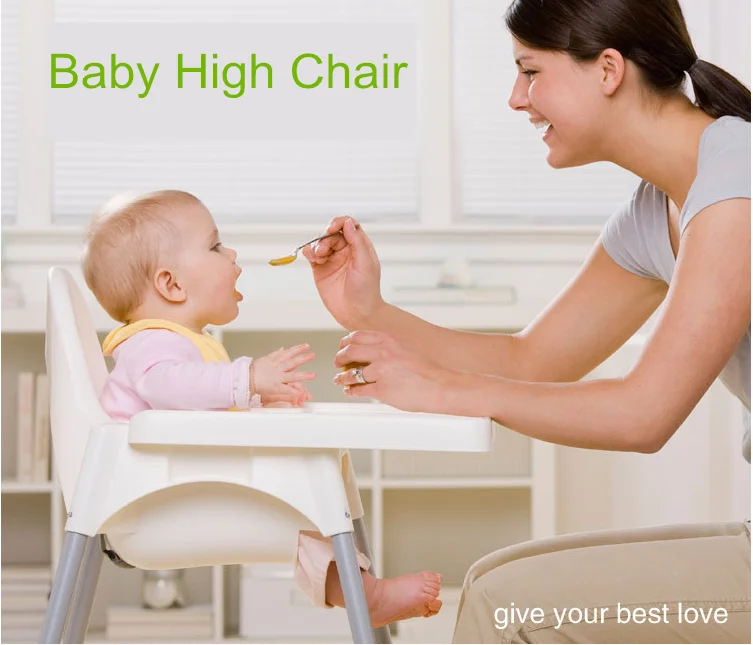 Even when salmon is labeled as boneless, it is possible to have tiny bones in it. If possible you need to use your fingers and have a keen eye for these very little things.
Even when salmon is labeled as boneless, it is possible to have tiny bones in it. If possible you need to use your fingers and have a keen eye for these very little things.
A single bone in a salmon can pose a choking hazard to your baby and as a mother you would want to exercise double precaution before giving salmon to your baby.
Make sure you’re buying high-quality salmon.
You should only feed your baby high-quality salmon. You want to make sure its packed with nutrients, has no harmful hormones or byproducts in it, and overall is fresh and raised sustainably. If you’re looking for a high-quality salmon that can be delivered directly to you, we recommend Oshēn Salmon which is the direct-to-consumer arm of BluGlacier. The salmon will ship directly to you and baby! You can also see our guide on how to shop for nutritious salmon at the grocery store.
Don’t be afraid to add in other ingredients!
As we mentioned above, you can try breast milk, water, and oils, But you can also get creative and try sweet potatoes, other vegetables, and even pastas! Just make sure you puree and mash the food up or study baby led weaning. Combining salmon with other goods is a great way to get your baby more nutrients. Just remember that doctors typically recommend introducing one new food to babies at a time to check for allergies.
Combining salmon with other goods is a great way to get your baby more nutrients. Just remember that doctors typically recommend introducing one new food to babies at a time to check for allergies.
How do you feed your baby salmon?
We would love to know what your favorite way to feed your baby salmon is! If you have any salmon recipes for babies you love please share! If you’re pregnant, definitely check out our post on why salmon is so good to eat during pregnancy.
What kind of fish to start the first feeding with
Many parents are afraid to introduce fish into their child's diet, given the fact that fish is one of the most common food allergies. Although fish may not seem like the best choice for baby food, certain types of fish, such as salmon and sardines, rich in omega-3 fats, have a positive effect on the development of a child's brain.
In this article, we will talk about the nutrients contained in salmon, at what age can you give red fish to children, and why it is a very good fish for the first feeding.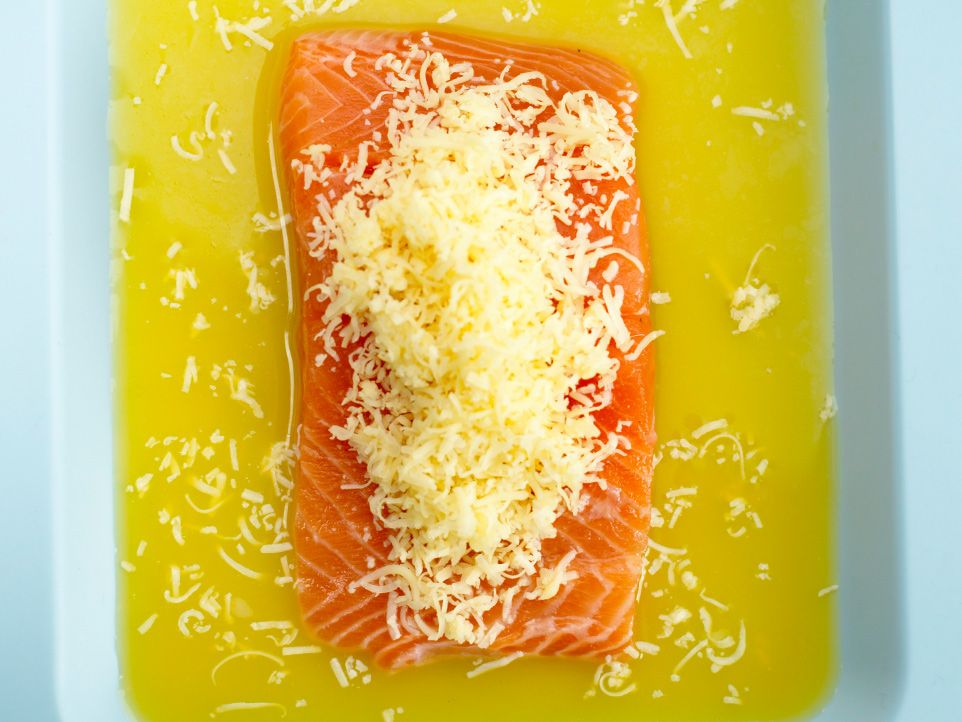
Is it safe for children to eat salmon?
Salmon is a rich source of important nutrients such as vitamin D, zinc, iron, protein and can be included in a child's diet provided the child is not allergic to it and eats it in moderation. And also after the child grows up a little.
At what age can you give salmon to a child?
Salmon or any other fish is not the best first food for a baby, so include it in your baby's diet when he is a little older, say at 7-8 months.
Also, don't forget to feed your child home-cooked salmon. Fish must be cooked properly and given to the child in small quantities. At the first injection, look for signs of allergy. Do not add any other new type of food with this fish. If you notice anything unusual, consult your pediatrician and stop giving fish to your child.
Why is salmon good for a child?
The nutrients found in salmon are very beneficial for a child's brain health. The benefits of omega-3 fatty acids for children include a positive effect on brain development, the functioning of the nervous system, and the child's vision. Eating seafood early can help develop a taste for it. Including salmon in a child's diet can also help improve sleep.
The benefits of omega-3 fatty acids for children include a positive effect on brain development, the functioning of the nervous system, and the child's vision. Eating seafood early can help develop a taste for it. Including salmon in a child's diet can also help improve sleep.
Can salmon cause choking in babies?
Salmon is a very soft fish, practically boneless. Unlike shellfish, which can become a choking hazard for both children and adults, salmon does not pose such a danger.
Be sure to run your hands over the fish to remove any bones before cooking baby salmon.
Can children be allergic to red fish ?
Although a very small percentage of people are allergic to salmon, salmon, like other types of fish, is a food allergen. As with other foods, be sure to give your child a sample of fish to test for allergies. Once you see that there are no adverse reactions, you can start increasing the amount of salmon in your child's diet.
Once you see that there are no adverse reactions, you can start increasing the amount of salmon in your child's diet.
Some family members may be allergic to seafood, in which case it is recommended to consult a doctor and an allergist to make sure your child is safe.
How feed a child fish from 6 months to 2 years
9000 time to introduce salmon into your child's diet. Make sure all bones are removed and the fish is fully cooked. A piece the size of two adult little fingers is a good portion of salmon for feeding a baby. This works because the meat is very tender and the small flakes are easy for a child to hold.
1 to 1.5 years
Great time to add canned salmon. Simply remove the fish from the jar, rinse off any excess salt, and then add it to a salad containing avocado, olive oil, or other ingredients of your choice.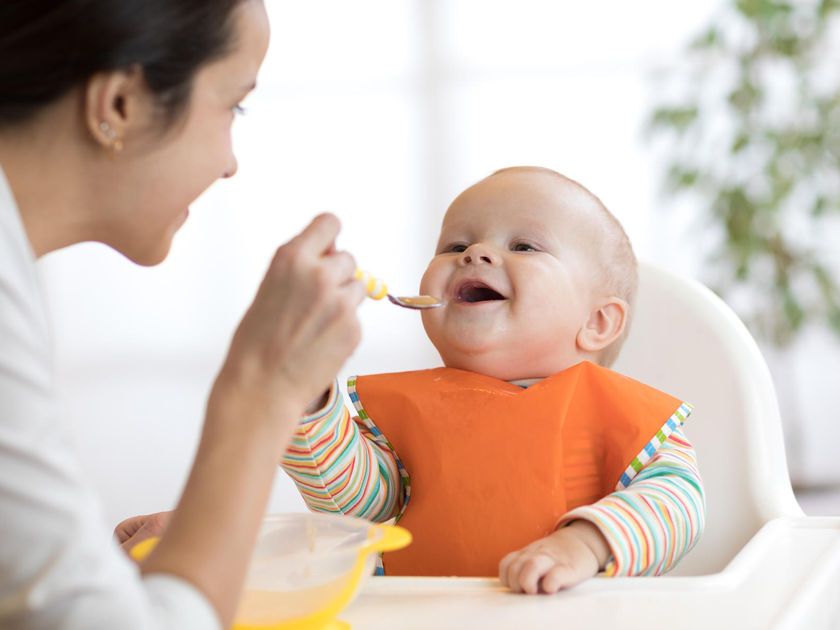 This is a one year old recipe.
This is a one year old recipe.
1.5 to 2 years
Salmon cakes are great dating food at this stage. Make sure you let your child feel the texture and shape of the fish. This will help him get used to the food he eats.
Useful recipes from salmon for child
1. Purex from salmon, broccoli and spinach 9000 . chopped shallots.
Preparation:
- Melt the butter in a pan and fry the shallots and potatoes for a couple of minutes.
- Add salmon and broccoli pieces and cook for 10 more minutes.
- Add spinach and cook 2-3 more minutes.
- Stir in the milk and let it boil for about 5 minutes.
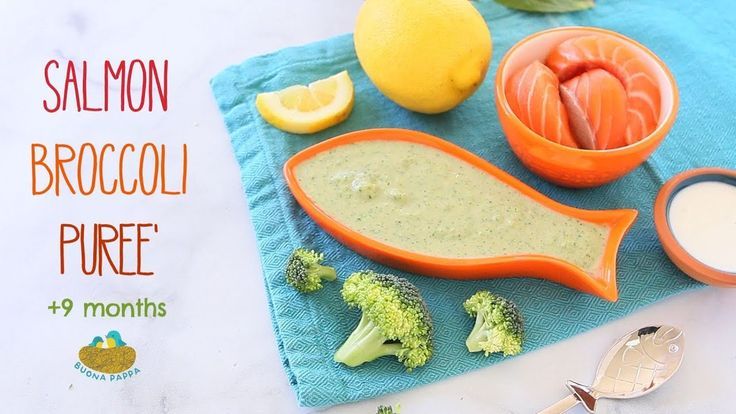 Then turn off the stove and let the mixture cool down.
Then turn off the stove and let the mixture cool down. - Stir the mixture until smooth and puree.
This recipe is ideal for babies aged 6 to 9 months.
2. Risotto with salmon
Ingredients:
- ¼ bulbs
- 1 Cam Cam Camer
- 150 Slosy fillet
- 1 tsp. vegetable oil
- 20 g peas
- 25 g white rice
Preparation:
- Preheat oven to 180 °C.
- Wrap the salmon in foil and place in the oven for about 20 minutes or until the meat is cooked through.
- Meanwhile, heat the oil in a frying pan and fry the onion and garlic.
- Add rice and peas.
- Add water, cover and simmer until the rice is fully cooked. This will take about 10 minutes.
- When the rice is ready, add the salmon. Cook for another 2-3 minutes, then turn off the heat.
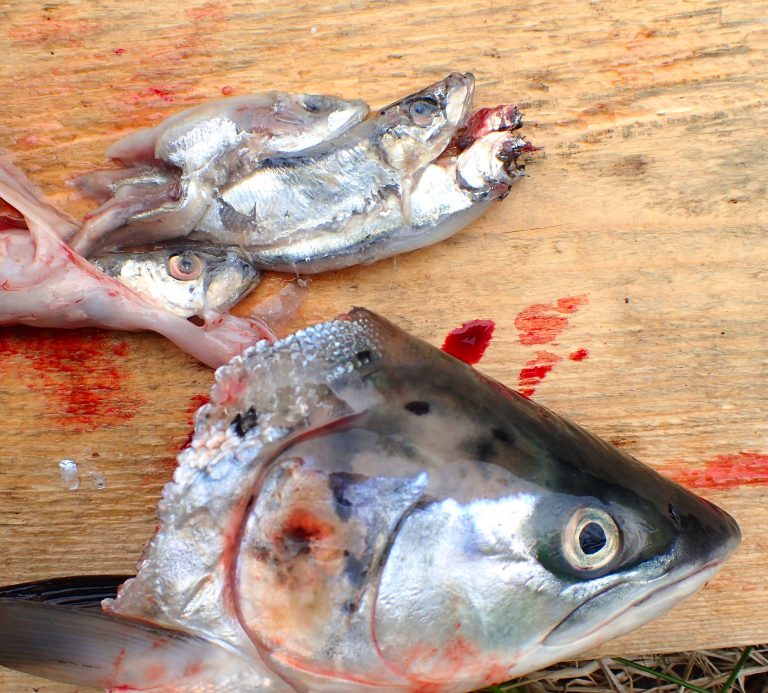
This recipe is ideal for babies 10 to 12 months old.
Salmon is very nutritious and can be included in a child's diet as soon as he starts eating solid food. Check with your pediatrician before including salmon in your child's diet. As soon as he gives the go-ahead, try the recipes above and let your child enjoy this delicious fish!
Follow us on Yandex Zen, subscribe to our Telegram channel!
-
Fast food: to give or not to give to children?
-
The healthiest foods for your child
-
Why is vitamin D so important for a child?
-
9 healthiest drinks during pregnancy
-
To give or not to give a tablet to a child?
-
Cheese in children's diet
Salmon in baby food
Feature: refers to fatty fish, not recommended for children under 3 years old.
Salmon - a genus of predatory fish of the salmon family.
Salmon lives in the northern waters of the oceans, spawning in autumn in the shallow waters of mountain rivers at temperatures up to 6 ° C.
B 100 g salmon 142 kcal.
| Vitamins | Macronutrients | Microelements |
| A (retinol) - 12 mcg B1 (thiamine) - 0.226 mg B2 (riboflavin) - 0.38 mg B3 (niacin) - 7.86 mg B5 - 1.664 mg B6 - 0.818 mg B9 (folic acid) - 25 mcg B12 - 3.18 mcg | Potassium - 490 mg calcium - 12 mg Magnesium - 29 mg Sodium - 44 mg Phosphorus - 200 mg | Iron - 0. Manganese - 16 mcg Copper - 250 mcg Zinc - 0.64 mg Selenium 36.5 mcg |
100 g salmon contains :
- Proteins - 19.84 g
- Fat - 6.34 g
- Water - 68.5 g
- Ash - 2.54 g
Salmon meat is considered an exquisite delicacy, it has a red color, high energy value, pleasant taste and delicate aroma. For industrial purposes, salmon (most often caged salmon) is grown on fish farms and in fish farms.
Salmon meat is energetically valuable, tasty and delicacy product. It is consumed after pre-treatment, but some seafood lovers believe that it can be eaten even raw.
Salmon benefits
Salmon contains polyunsaturated fatty acids, as well as omega-3 fats, which are involved in the regulation of cholesterol levels in human blood.
This favorably affects the state of the cardiovascular system, the functioning of the heart and blood vessels, prevents the formation of atherosclerotic plaques in the vessels, normalizes the work of the most important organs: the brain, heart and kidneys.
Potassium and calcium contained in salmon help to strengthen the musculoskeletal system, and phosphorus, vitamins B12, A, D take an active part in the functioning of the liver.
Read also: 3 delicious fish recipes
Contraindications for use
Despite the fact that salmon is a valuable food product in terms of composition and properties, it is not recommended for pregnant women and nursing mothers to consume it. The fact is that some types of salmon fish may contain mercury in their composition. In microdoses, mercury does not have a negative effect on a woman's body, but a newborn baby or embryo can have a negative effect.
Also, salmon should not be abused by people suffering from obesity and chronic diseases of the stomach, intestines and liver, since the product is considered quite fatty.
Salmon in children's diet
Despite the beneficial properties of fish, be careful, it can cause allergies in babies.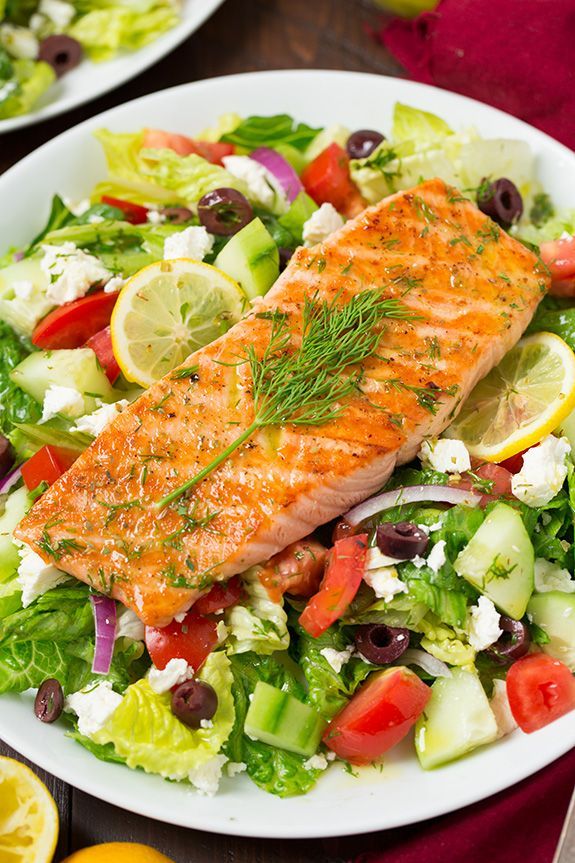 That is why children with a tendency to this disease should not be given fish until they are 3 years old.
That is why children with a tendency to this disease should not be given fish until they are 3 years old.
Carefully separate the meat from the bones.
It is necessary to introduce fish into complementary foods from half a teaspoon, preferably in the morning. If the child's body does not show allergic reactions, the portion can be increased to 50 g per day for babies up to a year and 60-100 g for older children.
See also: baby food Heck
Preparation and consistency
If you buy fresh fish for a child, inspect it carefully: the back should be fleshy and not pointed, the scales should be shiny and tight to the body, and the gills should be bright red or pink.
Toddlers usually like fish that is steamed or baked in the oven. From fish you can cook delicious cutlets and meatballs, and for older children - fish pies and casseroles. Please note that children under 3 years of age should not be given fried fish. Until the age of 3, also exclude fish broth!
Salmon dishes for children
Rice casserole with salmon from 3 years old
Ingredients:
- Salmon - 250 g
- Green beans - 150 g
- Cheese - 80 g
- Egg - 1 pc.
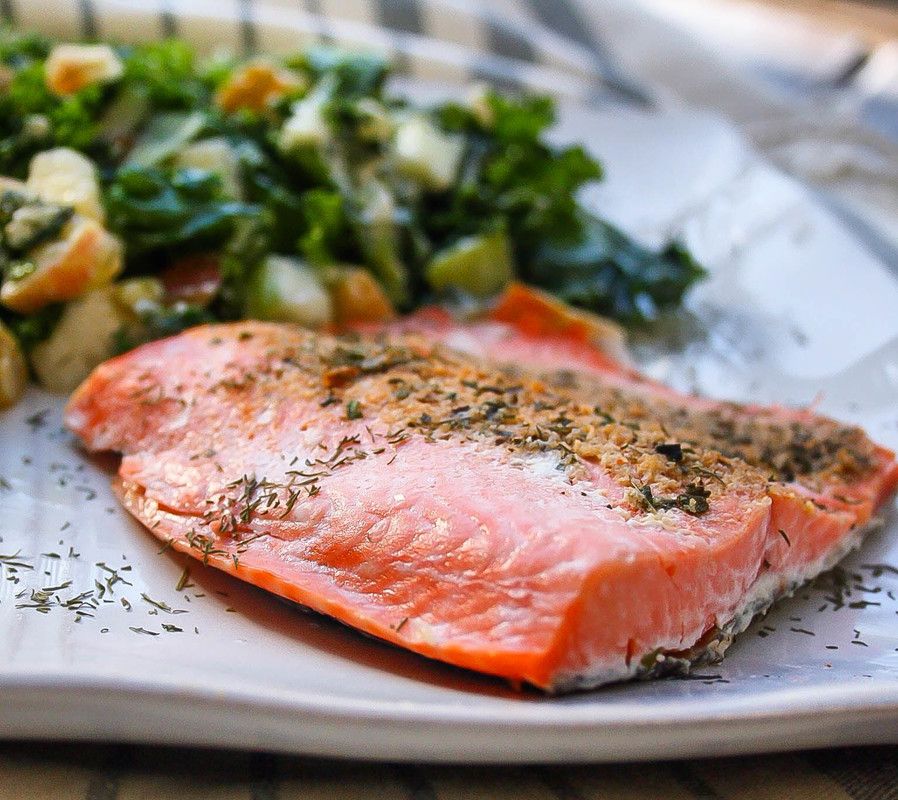
- Rice - ¾ tbsp.
- Lemon juice - 2 tbsp.
- Dill
- Salt - to taste
Preparation:
- Cut the fish into cubes, sprinkle with lemon juice and sprinkle with salt, leave to marinate.
- Boil rice in salted water, avoiding boiling, let it cool.
- Put the fish in a pan with vegetable oil, fry for a couple of minutes.
- Put asparagus (green) beans to the fish, pepper and salt, fry over high heat for 2-3 minutes, stirring constantly.
- Crack the egg into the slightly cooled rice, add half of the grated cheese, chopped dill, mix, arrange in greased molds, put the fish and beans on top, then put the remaining cheese into the molds.
- Rice casserole with salmon is being prepared in an oven preheated to 170 degrees for 15 minutes until golden brown.
Creamy soup with salmon - from 3 years old
Ingredients:
- Water - 1.
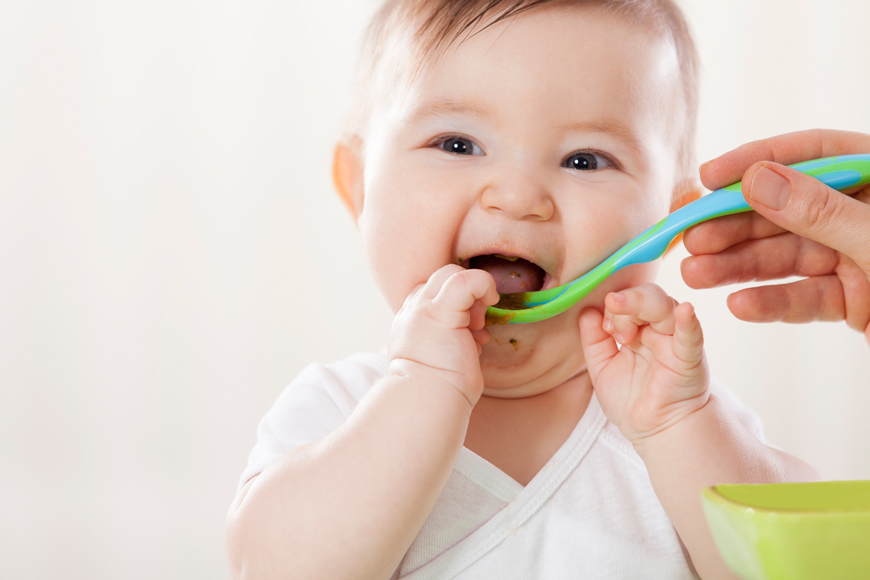 5 l
5 l - Salmon - 400 g
- Onion - 1 piece
- Potatoes - 4 pcs
- Black pepper (peas) - 6 pcs
- Cream (10-20% fat) - 200 ml
- Wheat flour - 1 tbsp. l.
- Salt - 2 tsp
- Butter - 30 g
- Dill - 1/3 bunch.
Preparation:
- Fillet the fish.
- Cook a clear broth from the tail, adding coarsely chopped onion, peppercorns.
- Cut the fish fillet into pieces.
- Cut the potatoes into small strips.
- Remove the onion and fish tail from the broth.
- Then we put chopped potatoes in the broth, it is necessary to reduce the heat and cook from the moment of boiling for 5 minutes.
- Dip the fillet pieces into the soup and cook for another 10 minutes.
- Mix flour with cream until smooth.
- Pour into soup while stirring constantly. Warm up on a small fire, salt.
- Season with butter and parsley!
Salmon and asparagus pie from 3 years old
Ingredients:
- Salmon - 400 g
- Asparagus - 1 ban.


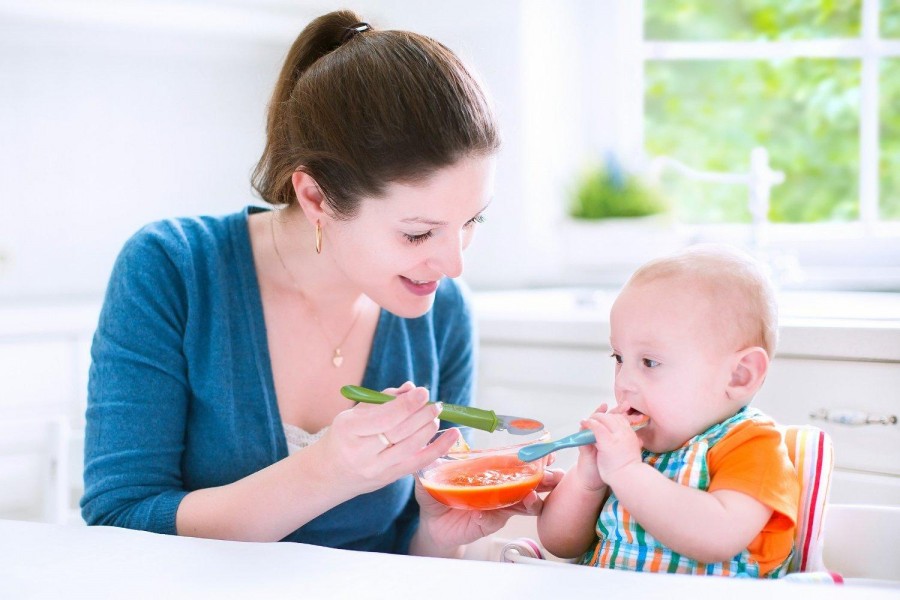 8 mg
8 mg 




